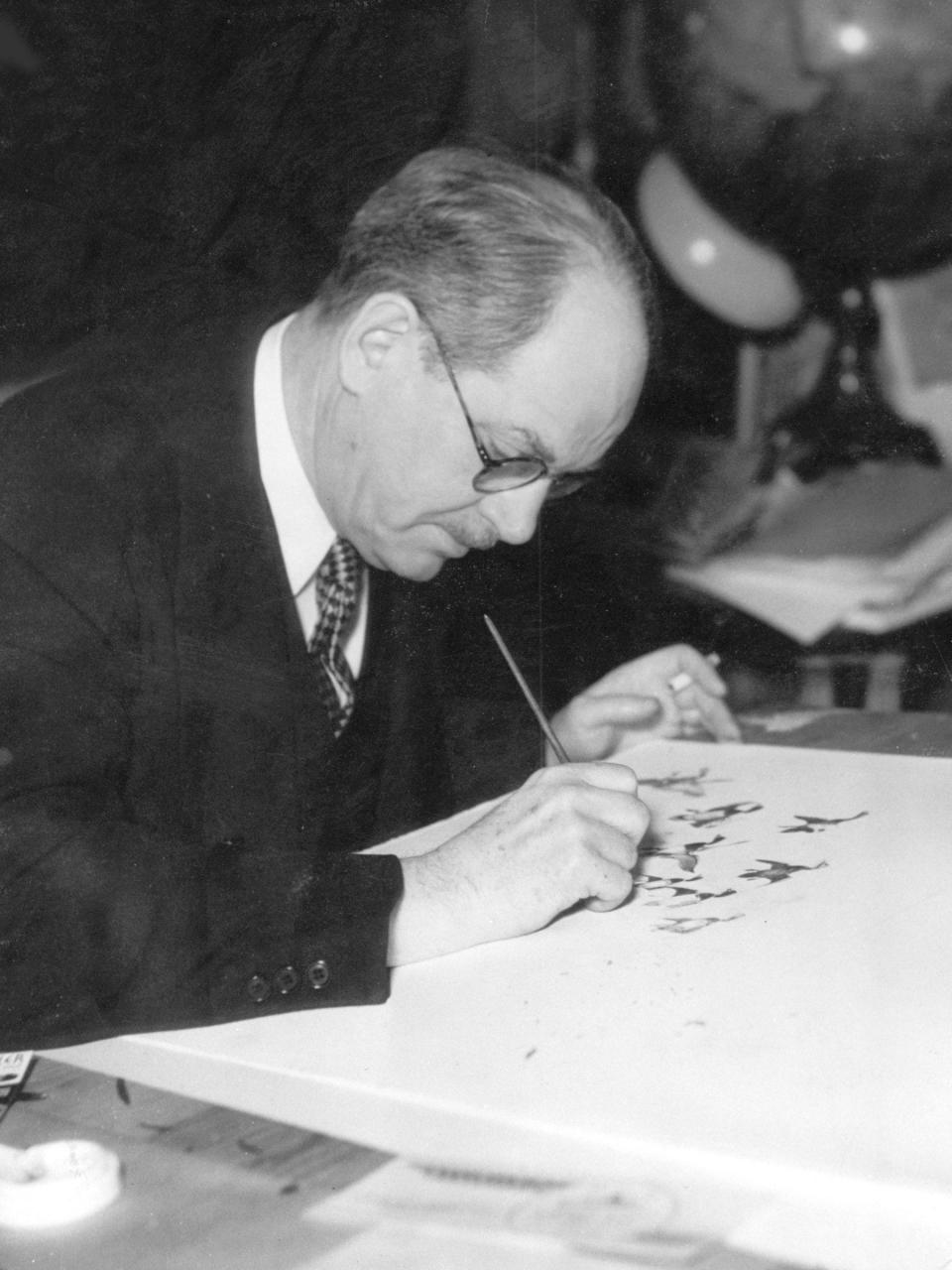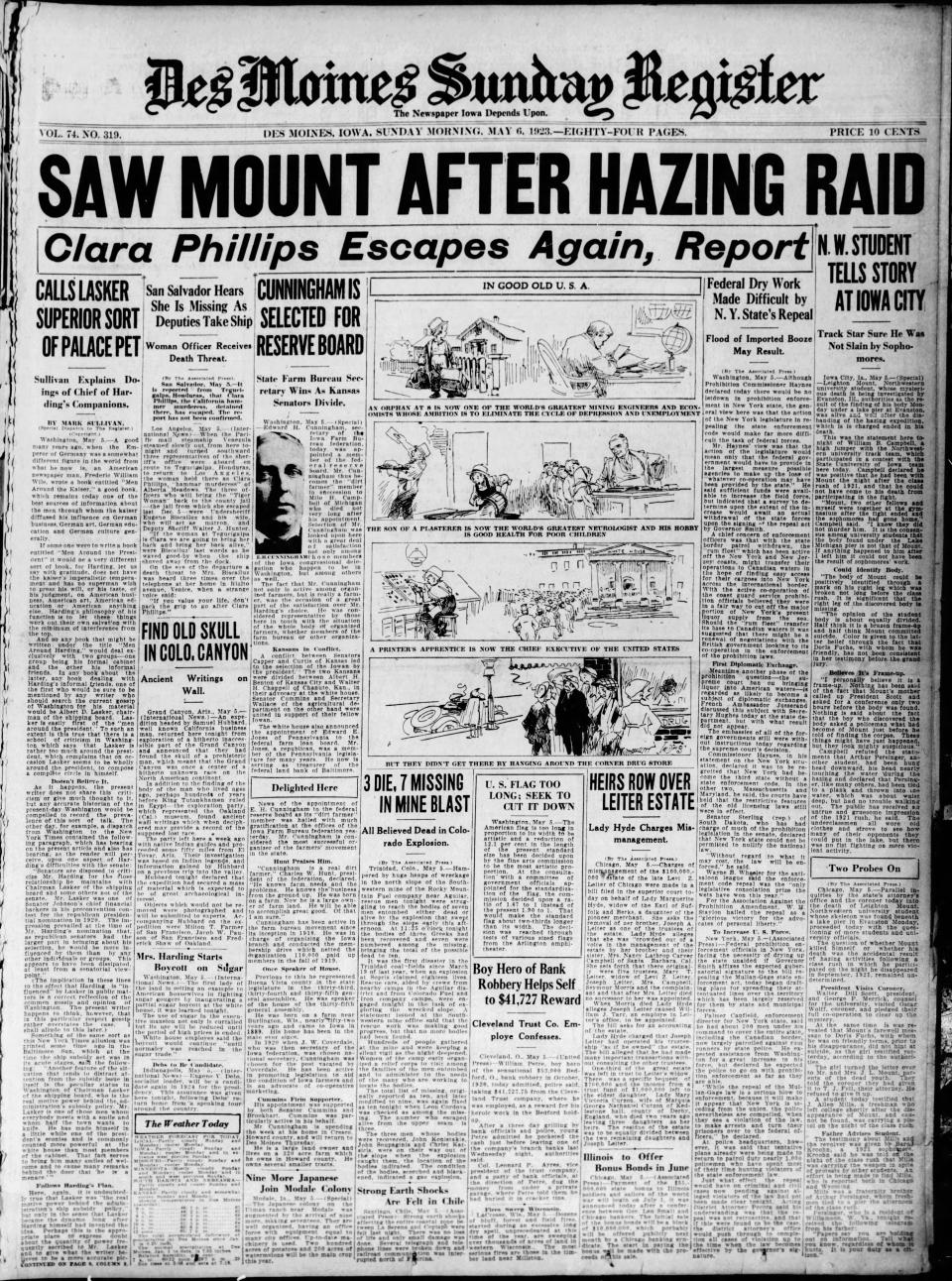'Ding' Darling won 2 Pulitzer Prizes, blazed a path for wildlife conservation nationally
- Oops!Something went wrong.Please try again later.
A pantheon of distinguished journalists has worked at the Des Moines Register and its predecessors, not only as leaders in their own profession but often also shaping state and national affairs.
The luminaries include Gardner Cowles, owner and publisher for over 40 years starting in 1903, and his sidekick as editor, Harvey Ingham, who also served for 40 years. They built the newspaper into a financial success while steering it away from its partisan roots to become a more independent news source.
Or, as a more recent example, Michael Gartner, editor and president of the Register in the 1970s and 1980s, went on to become president of NBC News, won a Pulitzer Prize for editorial writing while editor and co-owner of the Ames Daily Tribune and helped revitalize cities across Iowa as chairman of the Vision Iowa board.

But my pick for the single most distinguished alumnus over the entire 175-year span of Register history would be editorial cartoonist J.N. “Ding” Darling, a two-time Pulitzer Prize winner who stands out for his sheer talent, the prodigious body of his work (he drew cartoons for the Register on and off from 1906 to 1949) and for his impact on the national stage and lasting legacy as a conservationist.
Who was 'Ding' Darling? A transplant who sunk deep Iowa roots
Darling was born in Michigan in 1876 but moved in 1885 with his family to Sioux City, where his father was a minister.
“He loved the tall grass fields in South Dakota where he and his brother played,” according to the Sioux City Public Museum website, a good place to start learning about him. “Darling sat on the banks of the Missouri and Big Sioux rivers listening to the sounds of nature on summer nights. It was in the prairies around Sioux City that Darling discovered his love of nature.”
After college, Darling became a reporter for the Sioux City Journal and began sketching for fun on the side. The museum describes his first cartoons as “generally harmless fun” and dates his first political cartoon to 1901, in support of President Theodore Roosevelt’s campaign to create a forestry service.
His cartoons captured attention across the state. The Register lured him away in 1906 and began publishing his cartoons on the front page. At the Register, he began signing his cartoons as "Ding" — a contraction of his last name.
His cartoons on the 1908 presidential race, when Republican William Howard Taft defeated three-time Democratic nominee William Jennings Bryan, “skyrocketed him to enormous success,” the museum says, and he took a short detour to the New York City Globe before returning to Des Moines and the Register.

He won his first Pulitzer in 1924, for “In Good Old USA,” a commentary on American life in which he lauds rags to riches success stories while admonishing a cluster of loiterers: “But they didn’t get there by hanging around the corner drug store.”
While his subjects were wide-ranging, Darling, an avid hunter and fisherman, often focused on wildlife, soil and water conservation. But he did far more for this cause beyond his advocacy through cartoons. Using $9,000 of his own money, he established the first Cooperative Wildlife Research Unit at Iowa State College, now Iowa State University, to bring more science to bear on managing natural resources.
According to an Iowa State history, Darling fought to divorce conservation activities in Iowa from political interference and was named the first chairman of the Iowa Fish and Game Commission, now the Iowa Department of Natural Resources, which spearheaded creation of a 25-year conservation plan for our state.
Then in 1934, President Franklin D. Roosevelt appointed him chief of the U.S. Biological Survey, a predecessor to the U.S. Fish & Wildlife Service, where he drew the first Federal Duck Stamp. Stamp sales have since raised over $1.2 billion to conserve 6 million acres of wetlands habitat on national wildlife refuges, according to the service.
And then in 1936, he persuaded Roosevelt to invite over 2,000 hunters, fishermen and conservationists to the first North American Wildlife Conference in Washington, D.C., which led to the founding of state wildlife federations and eventually the National Wildlife Federation, with Darling as its first president, according to his Fish & Wildlife biography.
He drew fewer cartoons during this period but took up his pen again to decry the rise of Adolf Hitler and the Nazi Party in Germany.
Six years before his retirement, in 1943, he won his second Pulitzer, for a cartoon on government waste, "What a Place For a Waste Paper Salvage Campaign."
'Ding' Darling's legacy lives on in Iowa, Florida, nationally
Darling was a member of the Des Moines Chapter of The Izaak Walton League of America, and another chapter was named after him. The Des Moines chapter, which declares itself the defenders “of soil, air, woods, water & wildlife,” has his photo and some of his drawings displayed “like a shrine” at its chapter house on George Flagg Parkway, according to a chapter director, Michael Delaney.
Delaney credits Darling with carrying on the tradition of former U.S. Rep. John F. Lacey of Iowa, known as the “Father of Federal Conservation Legislation” and other conservation pioneers such as Aldo Leopold and Theodore Roosevelt, “by focusing attention on the natural beauty and natural resources of Iowa and the United States.”
For years, Darling maintained a winter home on Captiva Island, Florida. When developers moved to buy up environmentally sensitive land on nearby Sanibel Island, Darling led neighbors’ efforts to block the sale and urged President Harry Truman to sign an executive order in 1945 creating the Sanibel National Wildlife Refuge, his Fish & Wildlife biography says. In 1967, it was renamed the J.N. “Ding” Darling National Wildlife Refuge.
The refuge is still recovering from the ravages of Hurricane Ian, but the main visitor and education center reopened in April 2023, six months after Ian's landfall. Ann-Marie Wildman, executive director of the “Ding” Darling Wildlife Society, said her organization continues to further Darling’s conservation ethic by preserving natural spaces in and near the refuge. Just last month, the organization closed on a 21.5-acre parcel that will complete a wildlife corridor.
What a proud legacy!
(You can peruse thousands of his digitized cartoons and other Darling papers, as well as hear audio clips of him speaking, in a special collection maintained by the University of Iowa Libraries.)
Carol Hunter is the Register’s executive editor. She wants to hear your questions, story ideas or concerns at 515-284-8545, chunter@registermedia.com, or on Twitter: @carolhunter.
This article originally appeared on Des Moines Register: Iowa's 'Ding' Darling won 2 Pulitzers, pushed wildlife conservation

